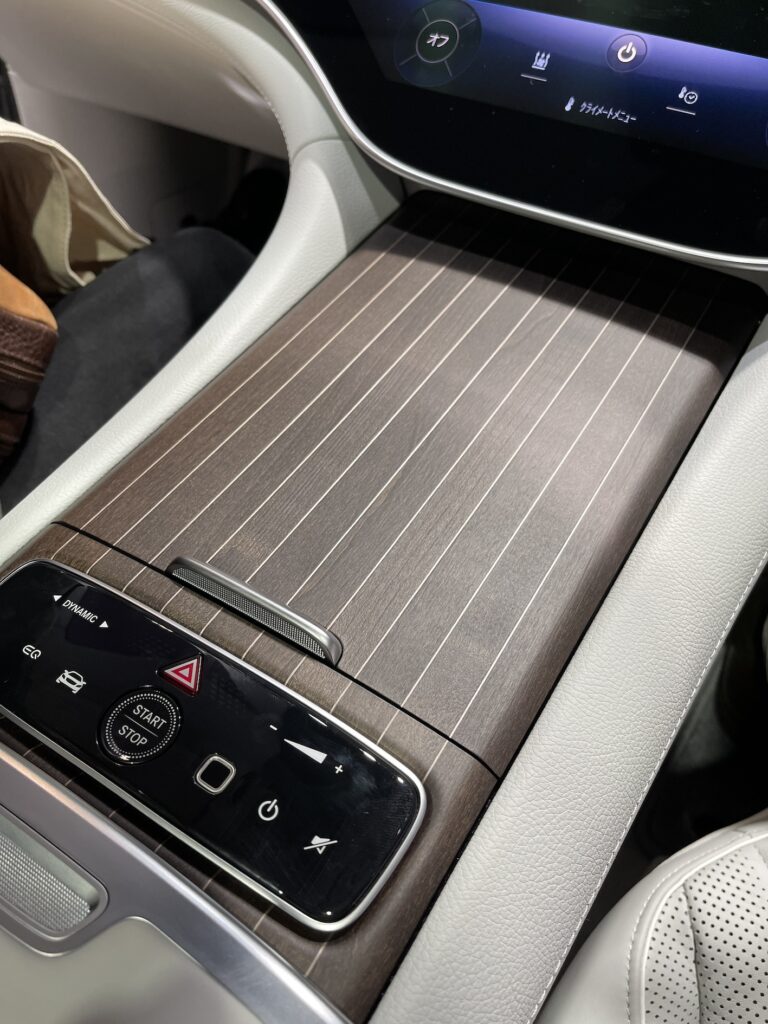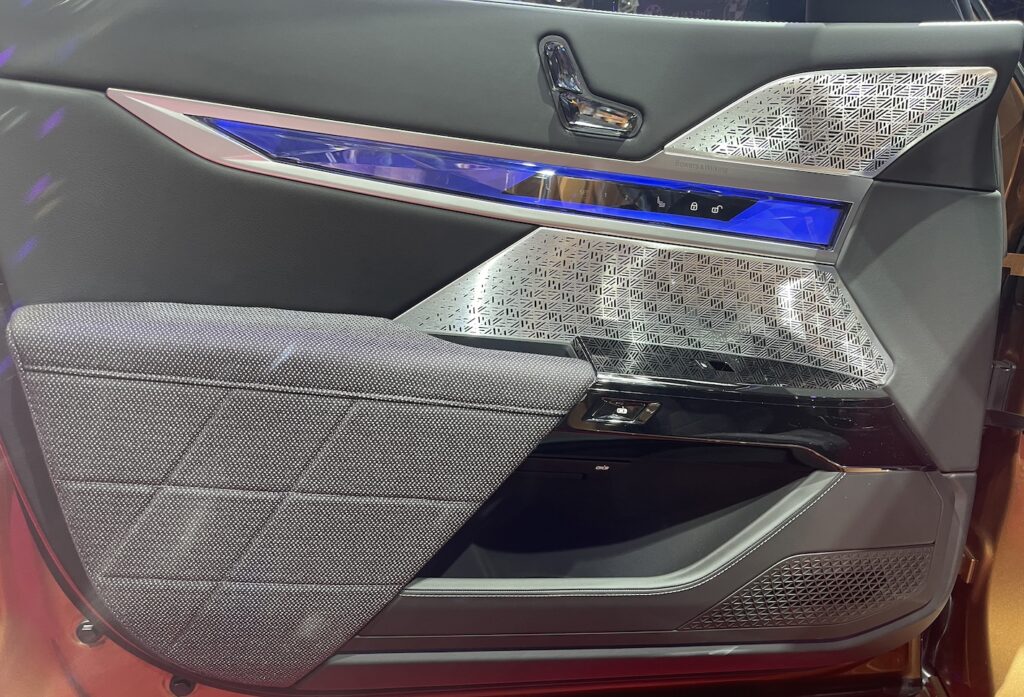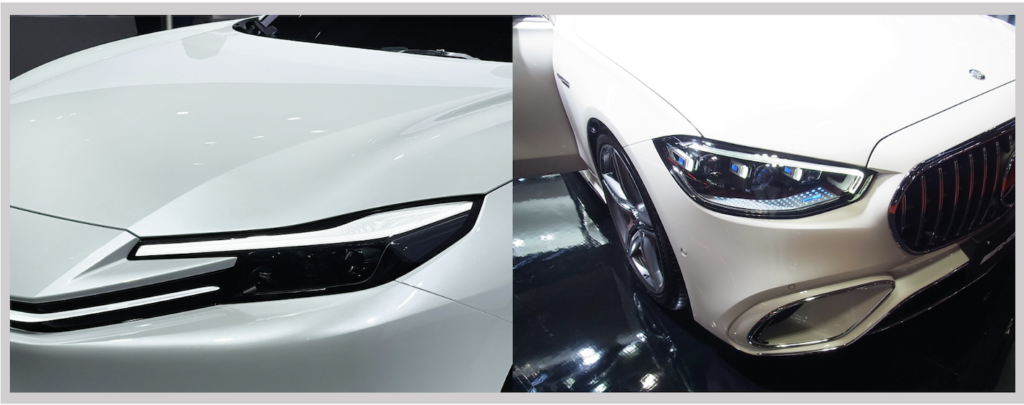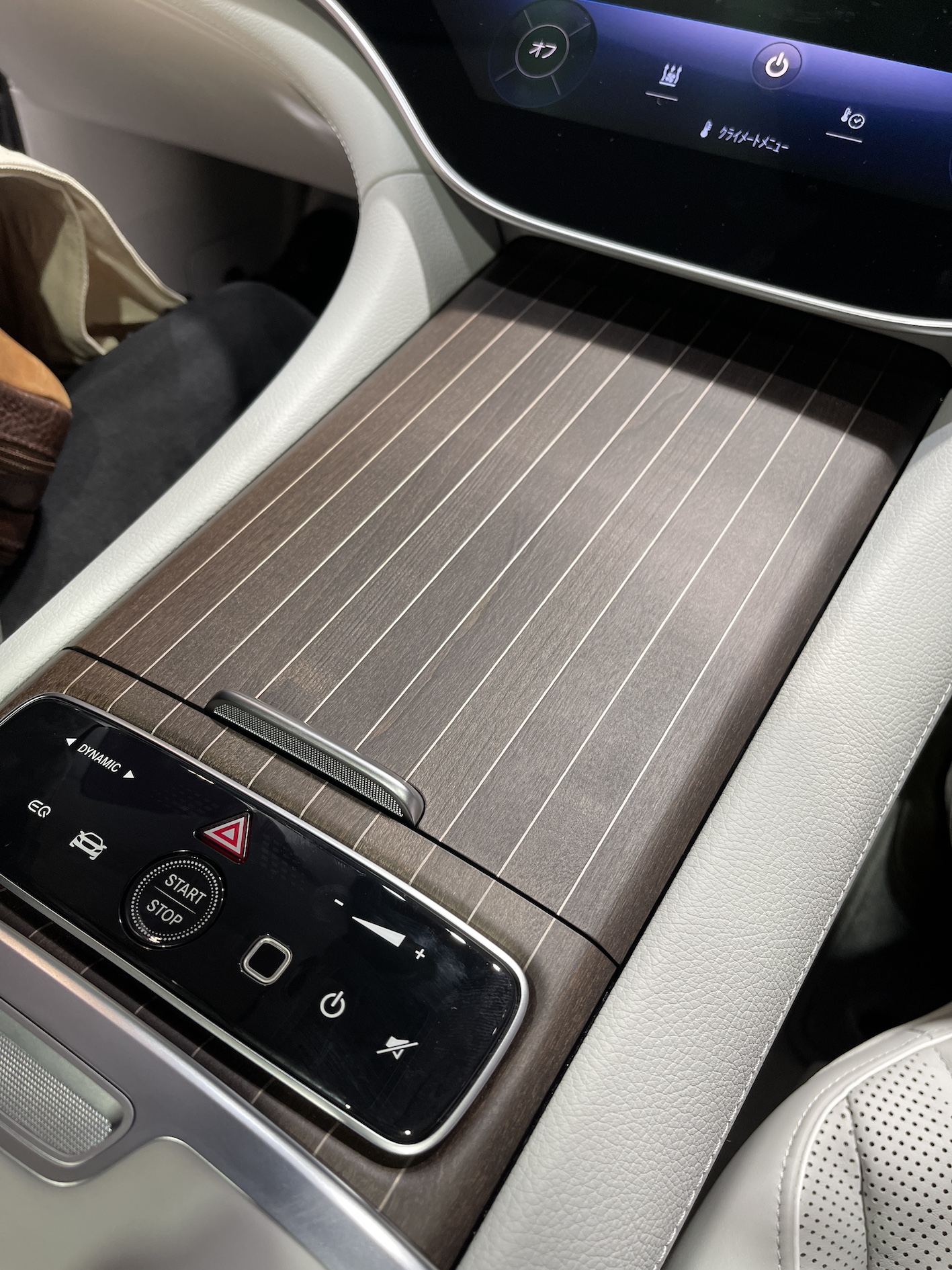CMFデザインは「超広範囲」
前回は、CMFはColor(色)/Material(素材)/Finish(表面加工などの仕上げ)のそれぞれの頭文字をとったこの言葉で、「カラー&マテリアル」「カラー&トリム」とも呼ばれ、クルマの内装/外装すべての色と素材のコーディネートを取り仕切るデザインで、クルマ1台の世界観を作り上げる大切な役割について書きました。
今回は、クルマという商品が開発される過程で、どのようにCMFが関わっているのかを取り上げながら、CMFデザインという仕事についてお話をしたいと思います。デザイナーとして日々仕事に従事されている方々には、今更感が強いとは思いますが、車両のCMFデザインに興味のある方、今後この世界に進んでみたいと考えておられる若い方たちのために、わかりやすい言葉でお伝えしたいと思います。
ひと言で言ってしまうと、CMFデザインは「超広範囲」な仕事です。
乗用車を例にとると、一般的に1台の新型モデルが世の中に出るまでの開発期間はおよそ3~4年程度*です。そのデザイン開発工程のなかで、エクステリア(外装)・インテリア(内装)合わせて諸々の仕事が発生しますが、CMFデザインはスタイリングデザインに比べて違う点があります。
大抵の場合ひとつの車種には複数のグレード展開があり、CMFでは各グレードに合わせてコンセプトを設定し、作り分けをしなくてはなりません。ひとつのスタイリングで3方向のグレード展開を設けている車の場合は、3種類のCMFコーディネートを構築しデザイン開発を進めます。また、日本国内のほかに海外への販売計画が設定されているケースも多く、その仕向け地の気候や生活、現地ユーザーの嗜好性に合わせた別のCMFデザイン計画も必要になります。
*車の開発期間はメーカーや車種により差があります。

上記はひとつの単純な例ですが、こんな具合に開発車種のコンセプトや販売計画によりCMFの仕事幅が増えていくという形になり、担当デザイナーはデザインセンスのほかにそれらを持続させる気力や体力も必要になります。しかし責任が大きい分やりがいもとても大きなものになる仕事なのです。
CMFデザインは「超細かい」
また、別の言い方で言うとCMFデザインは「超細かい」仕事です。勿論スタイリングデザインも繊細な仕事であることに変わりはありませんが、CMFの場合内装外装のあらゆる部位の色・素材・表面処理をトータルで開発するのでなかなか複雑です。
それも、モデル全体を俯瞰で離れて立体の表情を見る、あるいは内装空間全体のCMFバランスを検討するような大きな見方をしなければいけない一方、トリム表面のシボ*をミクロンの深度まで迫って試作検討したり、表皮材の繊維一本一本の色にこだわって何度も試作を重ねたりと、繊細な作業でのデザイン追求があり、このような大小の作業が日々ダイナミックに交錯します。
内装と外装の部品数は200~300点くらいの構成はザラで、その素材は金属、プラスティック、布、革、木、不織布等々多岐にわたっており、それぞれの色や表面加工をまとめていくというとても神経を使う細かい仕事でもあります。
*シボ:プラスティックや金属を成形・加工する際に表面に施す細かい凹凸の模様。傷付き防止、見映えや質感の向上、滑り止め効果、光の反射を和らげるなど様々な目的がある。 シボはクルマの中では地味な存在のように扱われがちだが、その模様や成型方法によりクルマのイメージや質感に大きく影響する奥深い要素の一つ。

エクステリアを例にとると、ボディカラーにおいても同じことが言えます。
例えば「ホワイト」とひとことで言っても微妙にアイボリーを感じたりブルーを感じたり、あるいは使用する光輝材*の種類と効果によって山ほどの「ホワイト」が存在しクルマの造形に大きく影響します。そのため造形意図とのマッチングを目指して微妙な違いの比較をしながら、狙いの色が出るまで何度も調色*&確認という作業を繰り返します。ただ調色を重ねれば綺麗な意図通りの色が作れるというわけではなく、ここにまたもうひとつコストとの闘いという高いハードルが存在するというようになかなか単純にはいきません(綺麗な塗料は高いのです。その理由はまたの機会に)。
また、塗装工場で何回塗り重ねることができるかという工程の制約も加わって思うような色にできないこともあるのです。
*光輝材:色に質感や高級感を出すため塗料に使用するアルミやガラス、雲母などを使用した粒子・フレーク状の素材。立体造形に豊かな表情を与える。「高輝材」とも書く。 *調色:開発プロセスの段階で行われる色の試作。外装内装部品ともに頻繁に行われる。

しかも、素材や表面処理では人が乗って動く乗り物としての安全性や機能性をしっかり満たしていないといけません。物性的な細かい数字データの順守義務があり、よいデザインと物性*のクリアという難しい課題に常に取り組んでいく姿勢が必要です。
*物性:一般には物質そのものの性質の事だが、ここでは人が車に乗る上で求められる様々な素材の性能の規格をクリアしていく意味で使われる。
CMFデザインは、ファッションの世界と似たところがあり、世の中の動向や消費者のマインドに大きく影響されるものです。特に色や素材などはこのトレンドがベースとなってデザインに関係してくるものなので、このトレンドの鮮度を考慮する関係上、クルマの長い開発工程において、割とその工程の後ろの方までデザイン仕様の決定で揉めたりすることが多々あるのも事実です。
そして、やっとクルマが市場に出た後、一定の期間が経つと、デザイン鮮度が若干落ちてしまう印象を、その時々にマッチングした表現などで新しくしていく、マイナーチェンジというプロセスもあります。ファッションと同じようにトレンドの動きを敏感にキャッチし、魅力的なクルマを世の中に出していくCMFデザイナーの腕の見せ所でもあります。このように、車種開発は終わりなく、しかし確実にバージョンアップしながら続いていきます。
当然ですが、このような仕事はひとりで進められるものではなく、工程時間や予算の管理を念頭に置きながら、チーム内でのコミュニケーション、関係部署やサプライヤー会社との協力と交渉など、その調整力もデザイン開発における重要な能力のひとつと言えます。
CMFデザインは「超面白い」
話が少し堅苦しくなってしまいました。
世の中のどんなものの開発でも言えることですが、自分の手掛けた製品が世の中に出た時の達成感は何物にも代えがたいものです。CMFデザインの場合、色や素材は第一印象を決定づける大切な要素であり、それだけに、自分が開発したボディカラーを纏い、複雑な工程を経て作られた内装空間を載せた実車が世界のいろいろな場所で走っているのを見るのは感無量ではないでしょうか。
クルマの開発には、それは大勢の人たちのパワーと思いが込められており、内外問わず一緒に関わった人たちと作り上げていく時の感覚は独特のものがあります。
そしてCMFデザイナーの方たちは、これに満足することなく、日々努力し続け、次なるものに挑んでいます。
クルマ全体を包括的に見て、スタイリングを引き立て、キャラクターを変えることができる魔法のような仕事、CMFデザインは、「超面白い」仕事なのです。
An important role in creating the world view of the car [ CMF Design Series Vol.2 ]
CMF design is a ‘super-extensive’
CMF is an acronym for Color/Material/Finish.
In the previous issue, I wrote about the important role of design, also known as “color and material” or “color and trim,” which coordinates all the colors and materials of a car’s interior and exterior and creates the world view of a single car.
In this issue, I would like to talk about how CMF is involved in the process of vehicle development and the job of CMF design.
I know that this may seem like a bit of a new idea to those of you who work as designers on a daily basis, but for those of you who are interested in CMF design for vehicles, or for young people who are thinking about entering this field in the future, I would like to explain in easy-to-understand terms.
In a word, CMF design is a ” super-extensive” job.
Taking passenger cars as an example, it generally takes about three to four years* to develop a new model before it is released to the market. During the design and development process, a variety of tasks are involved, including exterior and interior design, CMF design is different from styling design.
In most cases, a single car model has multiple grade developments, and the CMF must be conceptualized and created for each grade.
In the case of a car with a single styling and three-way grade development, three types of CMF coordination are constructed for design development.
In many cases, sales plans are set up for overseas sales in addition to Japan, requiring a separate CMF design plan tailored to the climate, lifestyle, and preferences of the local users in that destination country.
*The development time for a vehicle varies by manufacturer and model.

The above is a simple example, but the scope of CMF work increases according to the concept and sales plan of the vehicle to be developed, and the designer in charge needs not only a good sense of design but also the energy and stamina to sustain it. However, the greater the responsibility, the more rewarding the job becomes.
CMF design is a ‘super-detailed’
Or to put it another way, CMF design is a “super-detailed” job.
Of course, styling design is also a delicate job, but in the case of CMF, it is quite complex because it involves the total development of colors, materials, and surface treatments for every part of the interior and exterior.
While we have to look at the entire model from a bird’s eye view to see the three-dimensional expression or examine the CMF balance of the entire interior space, we also have to examine the grains* on the trim surface down to micron depth on prototypes, or repeatedly make prototypes with a focus on the color of each individual fiber of the surface skin material, The pursuit of design is a delicate process, and these large and small tasks are dynamically intermingled on a daily basis.
The number of interior and exterior parts is usually composed of 200 to 300 pieces, and the materials used are diverse, including metal, plastic, cloth, leather, wood, and non-woven fabric, etc. It is also a very nerve-racking and detailed job to put together the colors and surface finishes of each piece.
*Grain: A fine pattern of unevenness applied to the surface of plastic or metal during molding and processing. It has various purposes, such as preventing scratches, improving appearance and texture, preventing slipping, and softening the reflection of light. Although they tend to be treated as a humble part of a car, they are a profound element that greatly affects the car's image and texture, depending on the pattern and molding method.

Taking the exterior as an example, the same can be said for body color.
For example, the word “white” may have a subtle ivory or blue tinge, or there are many different “whites” depending on the type and effect of the Luminescent material* used, which greatly affects the car’s shape. Therefore, we repeat the process of color mixing* and checking colors over and over again until the desired color is achieved, comparing the subtle differences in order to match the intended modeling. It is not always possible to create a beautiful color as intended simply by repeating the color mixing process, but there is another high hurdle to overcome: the cost. (Beautiful paint is expensive. I’ll explain why another time.)
In addition, the process limitations of how many coats of paint can be applied in a paint shop can also add to the problem of not being able to achieve the desired color.
*Luminescent material: A particle/flake material made of aluminum, glass, mica, etc. used in paints to give texture and a luxurious look to colors. It gives a rich expression to three-dimensional modeling. Also written as "high-brightness material. *Color mixing: A trial coloring process that takes place during the development process. It is frequently used for both exterior and interior parts.

Moreover, the materials and surface treatment must meet the safety and functionality requirements for a vehicle that people ride on and move in. We are obliged to comply with detailed numerical data on physical properties, and we must always be ready to tackle the difficult issues of good design and meeting physical properties*
*Physical properties: Generally refers to the properties of the substance itself, but here it is used in the sense of meeting the standards for the performance of various materials required for people to ride in a car.
CMF design is similar to the fashion world in that it is greatly influenced by the trends of the world and the mindsets of consumers.
In particular, colors and materials are based on these trends and relate to the design, so in order to keep the trends as fresh as possible, design specification decisions are often tossed around until the very end of the long car development process.
Even when a car is finally launched, after a certain period of time, there is also the process of making minor changes with expressions that match the needs of the time in order to renew the impression that the design has lost its freshness.
As with fashion, this is a testament to the skill of CMF designers, who are sensitive to trends and bring attractive cars to the market.
In this way, the development of car models will continue with endless, but steady, upgrades.
Naturally, this type of work cannot be carried out by a single person, so keeping process time and budget management in mind, the designer’s coordination skills, such as communication within the team, cooperation and negotiation with related departments and supplier companies, are also important abilities in design development.
CMF design is a ‘super-fun’
The conversation has become a bit stilted.
As is true in the development of any product, the sense of accomplishment when a product you have worked on is released to the world is irreplaceable.
In the case of CMF design, colors and materials are important elements that determine the first impression, and for that reason, it must be a great feeling to see actual cars running in various places around the world, wearing body colors that you developed and interior spaces that were created through a complex process.
The development of a car involves the power and thoughts of a large number of people, and there is a unique feeling that comes from working together with those involved, both inside and outside the company, to create it.
And CMF designers are not satisfied with this, but continue to work hard and take on the challenge of what comes next.
CMF design is a “super interesting” job, a magical job that can enhance the styling and change the character of an entire car in a comprehensive way.

![by Car Styling [カースタイリング]](https://motor-fan.jp/wp-content/uploads/2025/04/carstyling-jp_logo.png)








